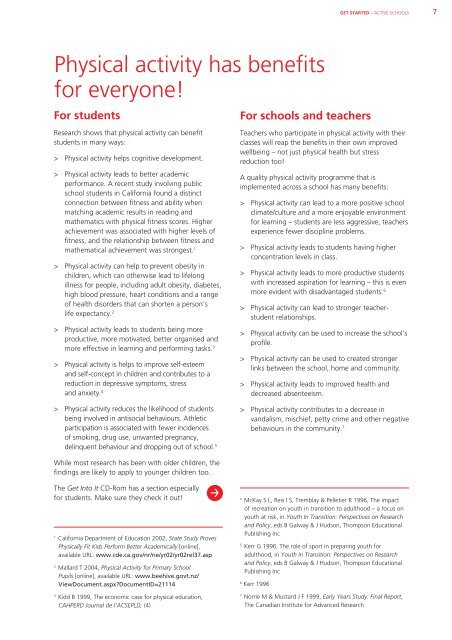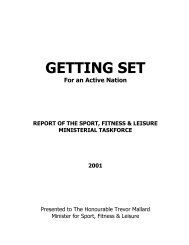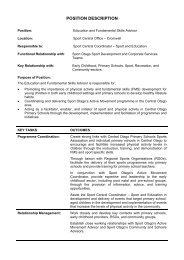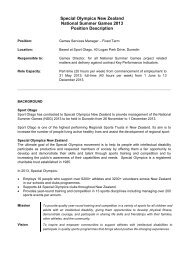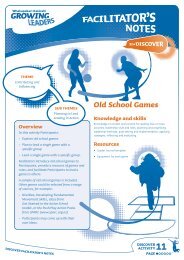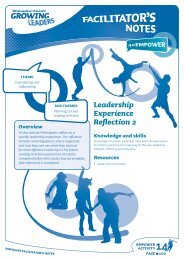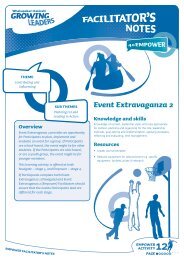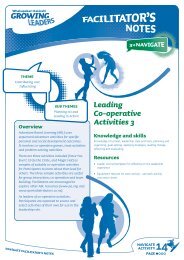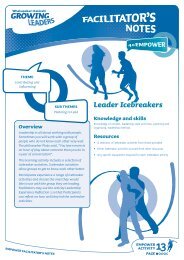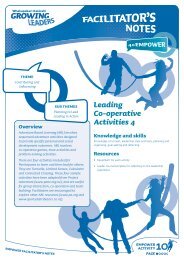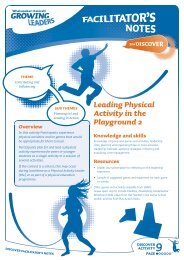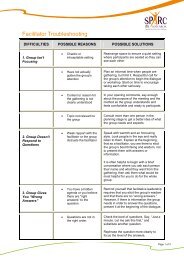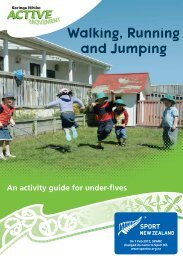Download Get Started (one document) - Sport New Zealand
Download Get Started (one document) - Sport New Zealand
Download Get Started (one document) - Sport New Zealand
You also want an ePaper? Increase the reach of your titles
YUMPU automatically turns print PDFs into web optimized ePapers that Google loves.
GET STARTED – ACTIVE SCHOOLS 7<br />
Physical activity has benefits<br />
for every<strong>one</strong>!<br />
For students<br />
For schools and teachers<br />
Research shows that physical activity can benefit<br />
students in many ways:<br />
> Physical activity helps cognitive development.<br />
> Physical activity leads to better academic<br />
performance. A recent study involving public<br />
school students in California found a distinct<br />
connection between fitness and ability when<br />
matching academic results in reading and<br />
mathematics with physical fitness scores. Higher<br />
achievement was associated with higher levels of<br />
fitness, and the relationship between fitness and<br />
mathematical achievement was strongest. 1<br />
> Physical activity can help to prevent obesity in<br />
children, which can otherwise lead to lifelong<br />
illness for people, including adult obesity, diabetes,<br />
high blood pressure, heart conditions and a range<br />
of health disorders that can shorten a person’s<br />
life expectancy. 2<br />
> Physical activity leads to students being more<br />
productive, more motivated, better organised and<br />
more effective in learning and performing tasks. 3<br />
> Physical activity is helps to improve self-esteem<br />
and self-concept in children and contributes to a<br />
reduction in depressive symptoms, stress<br />
and anxiety. 4<br />
> Physical activity reduces the likelihood of students<br />
being involved in antisocial behaviours. Athletic<br />
participation is associated with fewer incidences<br />
of smoking, drug use, unwanted pregnancy,<br />
delinquent behaviour and dropping out of school. 5<br />
Teachers who participate in physical activity with their<br />
classes will reap the benefits in their own improved<br />
wellbeing – not just physical health but stress<br />
reduction too!<br />
A quality physical activity programme that is<br />
implemented across a school has many benefits:<br />
> Physical activity can lead to a more positive school<br />
climate/culture and a more enjoyable environment<br />
for learning – students are less aggressive, teachers<br />
experience fewer discipline problems.<br />
> Physical activity leads to students having higher<br />
concentration levels in class.<br />
> Physical activity leads to more productive students<br />
with increased aspiration for learning – this is even<br />
more evident with disadvantaged students. 6<br />
> Physical activity can lead to stronger teacherstudent<br />
relationships.<br />
> Physical activity can be used to increase the school’s<br />
profile.<br />
> Physical activity can be used to created stronger<br />
links between the school, home and community.<br />
> Physical activity leads to improved health and<br />
decreased absenteeism.<br />
> Physical activity contributes to a decrease in<br />
vandalism, mischief, petty crime and other negative<br />
behaviours in the community. 7<br />
While most research has been with older children, the<br />
findings are likely to apply to younger children too.<br />
The <strong>Get</strong> Into It CD-Rom has a section especially<br />
for students. Make sure they check it out!<br />
1<br />
California Department of Education 2002, State Study Proves<br />
Physically Fit Kids Perform Better Academically [online],<br />
available URL: www.cde.ca.gov/nr/ne/yr02/yr02rel37.asp<br />
2<br />
Mallard T 2004, Physical Activity for Primary School<br />
Pupils [online], available URL: www.beehive.govt.nz/<br />
ViewDocument.aspx?DocumentID=21114<br />
3<br />
Kidd B 1999, The economic case for physical education,<br />
CAHPERD Journal de l’ACSEPLD, (4)<br />
4<br />
McKay S L, Reis I S, Tremblay & Pelletier R 1996, The impact<br />
of recreation on youth in transition to adulthood – a focus on<br />
youth at risk, in Youth In Transition: Perspectives on Research<br />
and Policy, eds B Galway & J Hudson, Thompson Educational<br />
Publishing Inc<br />
5<br />
Kerr G 1996, The role of sport in preparing youth for<br />
adulthood, in Youth In Transition: Perspectives on Research<br />
and Policy, eds B Galway & J Hudson, Thompson Educational<br />
Publishing Inc<br />
6<br />
Kerr 1996<br />
7<br />
Norrie M & Mustard J F 1999, Early Years Study: Final Report,<br />
The Canadian Institute for Advanced Research


